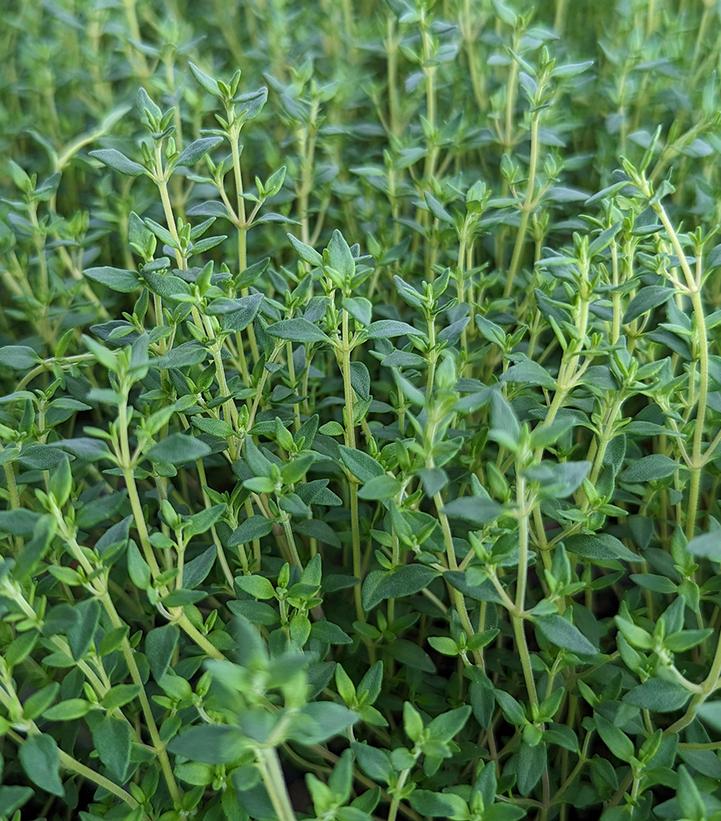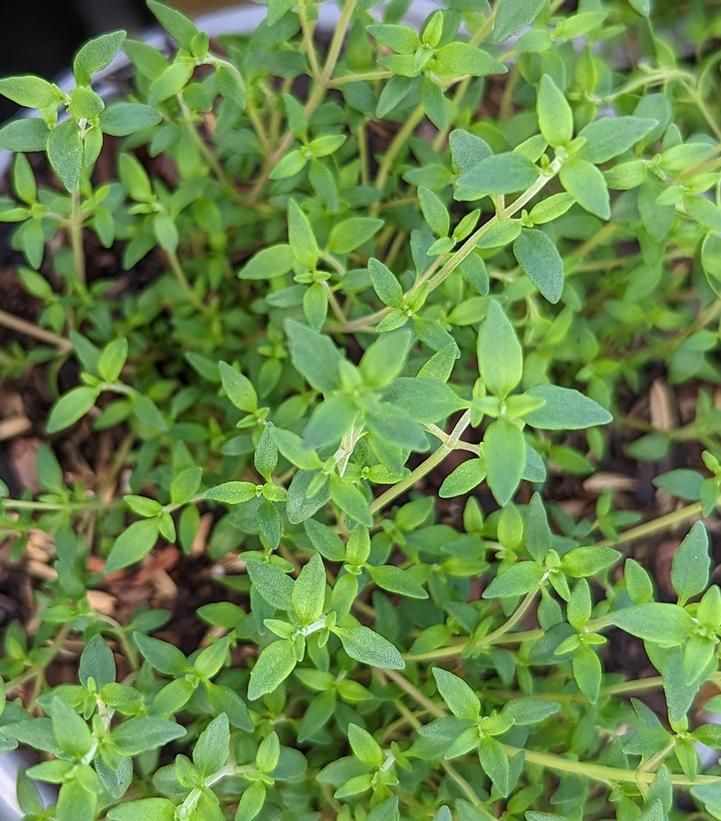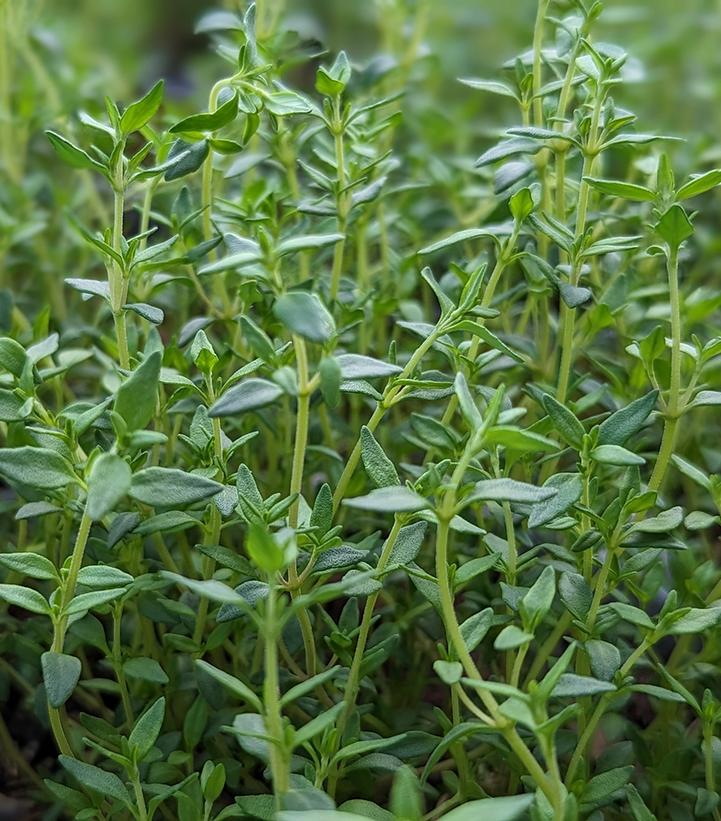





Thymus vulgaris
English Thyme
- Widely used thyme
- Great as a seasoning for any dish
- Low and spreading
- Lilac purple flowers in the summer
- Attracts bees
- Included in Recipe(s): Sara's Own Basil-Tomato Sauce, Ratatouille Provençale—Eggplant Casserole, Sara's Hearty White Bean and Fall Greens Soup, Spiced Lamb, Sara's Cherry Tomato Thyme, Vegetables a la Grèque, Thyme and Feta Vinaigrette, Island Roasted Chicken with Thyme Mustard Sauce, Sara's Savory Stuffing
- Category: Herbs, Edibles
- Hardiness Zone: 4-8
- Height: 12-15 in
- Spread: 10-12 in
- Bloom Color: Green Shades, Purple Shades
- Foliage Color: Green Shades
A superb perennial herb that is one of the backbones of any herb garden. Widely used as a seasoning for most any dish. English thyme loves full sun and well-drained soil and will even tolerate poor soils. Low and spreading with lilac-purple summer flowers that bees love! Perennial.
Attracts Wildlife
| • | Supports Bees |
Flower Color
| • | Purple |
Programs
| • | Sara's Superb Herbs |
Season of Interest (Flowering)
| • | Summer Bloomer |
Exposure
| • | Full Sun |
Additional Information about Thymus vulgaris
Also called garden thyme and German thyme. Thymus vulgaris is native to the western Mediterranean area, and now widely cultivated throughout temperate climes. Naturalized patches have been seen in western Massachusetts. Also, it can be found growing wild in the Catskill Mountains of New York where it is believed to have been introduced in the fleece of sheep imported from Greece. For the Greeks, thyme represented style and elegance. Its name may come from the Greek word for courage or the word meaning to fumigate. It was once burned in homes to get rid of stinging insects.
It was believed that fairies made their homes in patches of thyme, and gardeners of old set aside patches for them. In the Middle Ages, it represented chivalry. In France, it represented the Republican spirit. It was a flavor in liqueurs and cheese. Caraway thyme became the choice seasoning for beef. It was used medicinally to treat epilepsy, melancholy, the plague, and as an antiseptic on the battlefield in World War I. Thyme tea was believed to give shy persons courage and to alleviate nervous disorders and even nightmares.
Harvest and Use: Thyme is one of the fines herbes in French cuisine. This is a combination of minced chervil, parsley, thyme, and tarragon. The blend is appreciated for its freshness and its satisfying taste. It is added to food at the very last minute of cooking. Thyme is also one of the herbs in the classic blend called bouquet garni. This blend is tied in a cheesecloth bag or tucked between two stalks of celery and tied together to give flavor to the dish without the flecks. A bouquet garni includes thyme, parsley, bay, peppercorns, whole allspice, cloves, and marjoram. Tie it to the handle of the pot for easy removal.
Thyme, like parsley, goes with everything-veal, lamb, beef, poultry, fish, stuffing, stews, soups, sauces, stock, herb butters, flavored vinegars, beans, lentils, potatoes, tomatoes, cheese, onions, cucumbers, carrots, eggplant, leeks, mushrooms, eggs, and rice. I use it in every blend and with any food. If you ever find thyme-flavored honey, do not pass up this gourmet treat!
The essential oil is used to treat fatigue, depression, headache, respiratory problems and muscular pain. It is used in cough medicine. Mix it with a carrier oil and use as a chest rub. Apply it to insect bites and infected wounds. Add a few drops of pure essential oil to bathwater for weakness and arthritic conditions. Infusions are taken for flatulence, painful menstruation, chest infections marked by thick, yellow phlegm, stomach chills associated with diarrhea, and to gargle with for a sore throat. It blends well with bergamot, citrus oils, lemon balm, and rosemary. It has been shown to increase the production of white blood corpuscles in the presence of infections.
Thyme has uses other than medicinal and culinary. Add it to lavender to use as a moth repellent. The leaves and flowers make lovely sachets and can be added to potpourri. Thymol, one of its chemical constituents, which is also found in bee balm, has been used in colognes, aftershave lotions, soaps, detergents, toothpaste, mouthwash, and in external preparations for rheumatism. Thyme is antiseptic, stimulating, and a good cleanser, making it a good choice for an herbal bath.
Harvest small amounts throughout the season as needed. Cut back 2" from the ground for your main harvest in late summer. Taking a second harvest before winter may make plants less able to survive a cold, wet winter. To dry, tie bunches and hang in a warm, shady, airy site. Or you can strip the leaves from the stems and dry them on a close-meshed screen. Store in a tight-lidded jar in a cool, dark place. Thyme can also be frozen.
Growing & Maintenance Tips for Thymus vulgaris
Thyme goes with everything in cooking and there is a thyme, or even more than one, for every garden. Thyme is a good garden plant with a neat habit, fragrant foliage, and colorful flowers. It is an ideal edging plant and is a good choice for a windowsill herb. In companion planting, it enhances the growth of eggplant, potatoes, and tomatoes. It may repel cabbageworms and whiteflies.
English thyme is a small, evergreen, many-branched, aromatic shrub with gray-green leaves and white to pale purple flowers that bloom in summer. It is hardy to zone 4, likes a pH of 6.3, well-drained soil in full sun or partial shade. It tolerates poor soil.
